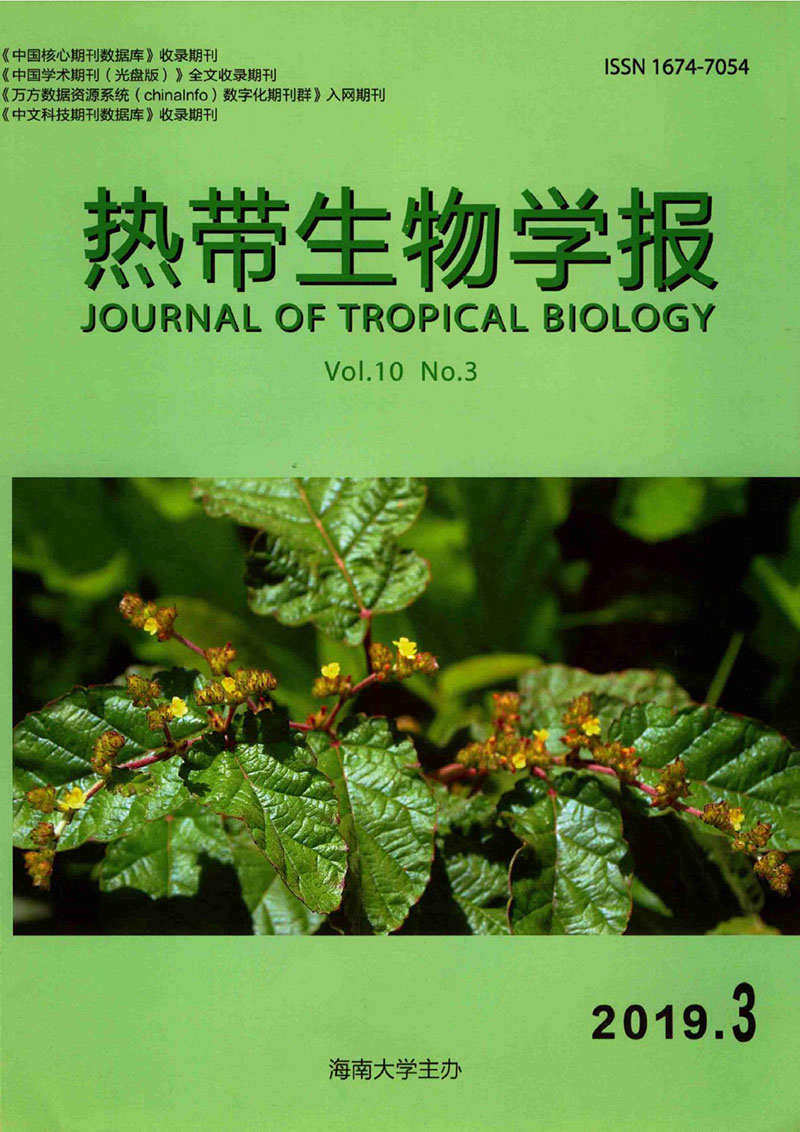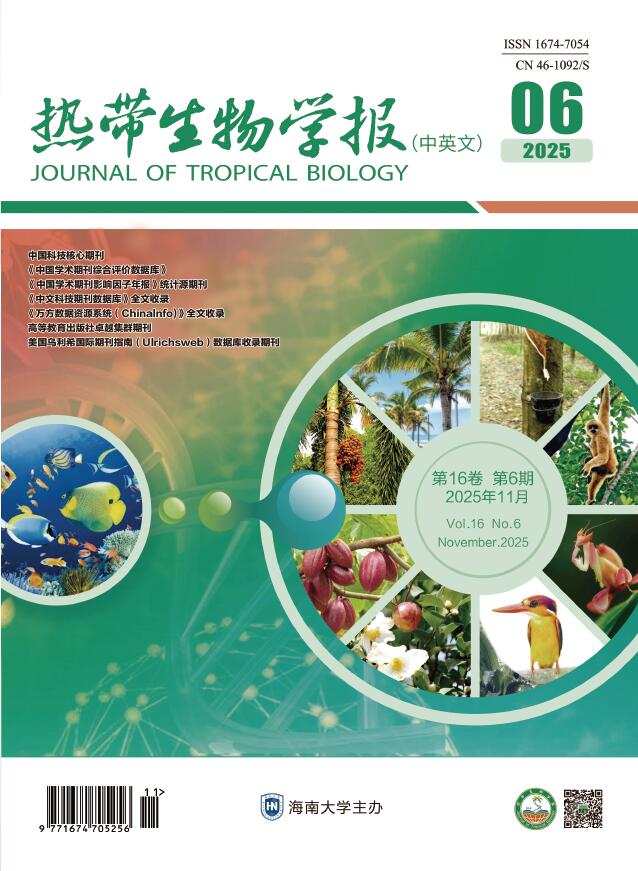2019 Vol. 10, No. 3
2019, 10(3): 215-221.
doi: 10.15886/j.cnki.rdswxb.2019.03.001
Abstract:
Eight cover crops Stålosanthes, Paspalum notatum Flugge, Poa annua L.,Arachis pintoi,Axonopus compressus P. P, Vicia villosa Roth, Festuca elata Keng ex E. were collected, extracted and used as donors to treat 2 species of weeds(Cynodon dactylon(L.) Pers. and Bidens pilosa L.) as receptors to observe their allelopathic effects on the weeds through indoor bioassay. The results showed that the aqueous extracts of 8 cover crops produced the highest inhibiting effect on the germination rate of Cynodon dactylon, a dual effect(promotion at a low concentration but inhibition at a high concentration) on the germination rate of B. pilosa, and an obvious inhibiting effect on the growth of seedling rhizome of B. pilosa, with a higher inhibition at a higher concentration. The aqueous extracts of 8 cover crops also showed an obvious inhibitory effect on the germination rate, root length and stem length of C. dactylon.
Eight cover crops Stålosanthes, Paspalum notatum Flugge, Poa annua L.,Arachis pintoi,Axonopus compressus P. P, Vicia villosa Roth, Festuca elata Keng ex E. were collected, extracted and used as donors to treat 2 species of weeds(Cynodon dactylon(L.) Pers. and Bidens pilosa L.) as receptors to observe their allelopathic effects on the weeds through indoor bioassay. The results showed that the aqueous extracts of 8 cover crops produced the highest inhibiting effect on the germination rate of Cynodon dactylon, a dual effect(promotion at a low concentration but inhibition at a high concentration) on the germination rate of B. pilosa, and an obvious inhibiting effect on the growth of seedling rhizome of B. pilosa, with a higher inhibition at a higher concentration. The aqueous extracts of 8 cover crops also showed an obvious inhibitory effect on the germination rate, root length and stem length of C. dactylon.
2019, 10(3): 222-225.
doi: 10.15886/j.cnki.rdswxb.2019.03.002
Abstract:
The seeds and leaves of Vitex trifolia were extracted by cold leaching method, and the crude extract was used to determine the antagonistic activity of plant pathogenic fungi by growth rate method. The results showed that the seed and leaf crude extract had different inhibitory ability to the target pathogen. The leaf crude extract had the best antifungal effect on Fusarium graminearum, and its inhibitory rate could be upto 50% at the late stage of culture, while the seed crude extract had a good antifungal activity against Magnaporthe oryzae, F. graminearum and Botryosphaeria dothidea. The seed crude extract had a higher antifungal activity than the leaf crude extract, and its EC50 values against F.graminearum and Alternaria alternata were 112.53 g·L-1 and 142.49 g·L-1, respectively.
The seeds and leaves of Vitex trifolia were extracted by cold leaching method, and the crude extract was used to determine the antagonistic activity of plant pathogenic fungi by growth rate method. The results showed that the seed and leaf crude extract had different inhibitory ability to the target pathogen. The leaf crude extract had the best antifungal effect on Fusarium graminearum, and its inhibitory rate could be upto 50% at the late stage of culture, while the seed crude extract had a good antifungal activity against Magnaporthe oryzae, F. graminearum and Botryosphaeria dothidea. The seed crude extract had a higher antifungal activity than the leaf crude extract, and its EC50 values against F.graminearum and Alternaria alternata were 112.53 g·L-1 and 142.49 g·L-1, respectively.
2019, 10(3): 226-230.
doi: 10.15886/j.cnki.rdswxb.2019.03.003
Abstract:
With Ralstonia solanacearum as a test strain, antibacterial activities of extracts from 31 species of Yao medicinal plants were screened by double dilution method, and the minimum inhibitory concentrations(MICs) of the extracts with high inhibitory activity against Ralstonia solanacearum, Bacillus cereus and Staphylococcus aureus were determined. The results showed that extracts from 18 species of Yao medicinal plants showed significant antibacterial activity at the concentration of 500 mg·L-1. Further test showed that the extracts from three species of the Yao medicinal plants, such as Cudrania cochin, Calophyllum membranaceum and Dryopteris setosa, had significant bacteriostatic activity against R.solanacearum at the concentration of 100 μg/mL. The MICs for these three species were 25 mg·L-1, 25 mg·L-1 and 25 mg·L-1, respectively, against R.solanacearum, 12.5 mg·L-1, 50 mg·L-1, respectively, against Bacillus cereus, and 50 mg·L-1, 25 mg·L-1, and 50 mg·L-1, respectively against Staphylococcus aureus.
With Ralstonia solanacearum as a test strain, antibacterial activities of extracts from 31 species of Yao medicinal plants were screened by double dilution method, and the minimum inhibitory concentrations(MICs) of the extracts with high inhibitory activity against Ralstonia solanacearum, Bacillus cereus and Staphylococcus aureus were determined. The results showed that extracts from 18 species of Yao medicinal plants showed significant antibacterial activity at the concentration of 500 mg·L-1. Further test showed that the extracts from three species of the Yao medicinal plants, such as Cudrania cochin, Calophyllum membranaceum and Dryopteris setosa, had significant bacteriostatic activity against R.solanacearum at the concentration of 100 μg/mL. The MICs for these three species were 25 mg·L-1, 25 mg·L-1 and 25 mg·L-1, respectively, against R.solanacearum, 12.5 mg·L-1, 50 mg·L-1, respectively, against Bacillus cereus, and 50 mg·L-1, 25 mg·L-1, and 50 mg·L-1, respectively against Staphylococcus aureus.
2019, 10(3): 231-234.
doi: 10.15886/j.cnki.rdswxb.2019.03.004
Abstract:
Leaves of coriander(Eryngium foetidum) were extracted with ethanol as extraction solvent, and their contents of total polyphenols and flavonoids, the scavenging effect on DPPH radical and hydroxyl radical and the reduction ability of high-valence iron ion were determined. The results show that the total polyphenol content, the total flavonoids content, the 50% inhibitory concentration(IC50) of DPPH radical scavenging effect, the 50% inhibitory concentration(IC50) of hydroxyl radical scavenging effect, and the reduction ability of high-valence iron ion of the ethanol extract from coriander leaves was(23.20±0.01) mg GAE/(g·DW-1),(0.96±0.02) mg RE/(g·DW-1), 0.48 g·L-1, 0.43 g·L-1, and 0.72 M Fe2+/(g·DW-1). The extract had lower DPPH radical scavenging rate and hydroxyl radical scavenging rate than rutin and TBHQ.
Leaves of coriander(Eryngium foetidum) were extracted with ethanol as extraction solvent, and their contents of total polyphenols and flavonoids, the scavenging effect on DPPH radical and hydroxyl radical and the reduction ability of high-valence iron ion were determined. The results show that the total polyphenol content, the total flavonoids content, the 50% inhibitory concentration(IC50) of DPPH radical scavenging effect, the 50% inhibitory concentration(IC50) of hydroxyl radical scavenging effect, and the reduction ability of high-valence iron ion of the ethanol extract from coriander leaves was(23.20±0.01) mg GAE/(g·DW-1),(0.96±0.02) mg RE/(g·DW-1), 0.48 g·L-1, 0.43 g·L-1, and 0.72 M Fe2+/(g·DW-1). The extract had lower DPPH radical scavenging rate and hydroxyl radical scavenging rate than rutin and TBHQ.
2019, 10(3): 235-239.
doi: 10.15886/j.cnki.rdswxb.2019.03.005
Abstract:
Pakchoi, cucumber and cabbage were sprayed with 2% toosendanin EC, MEC or WP by using four different fan-shaped spray nozzles from a German company Lechler, ST110-03, ST110-04, ST110-05 and ST110-06, to analyze the relation between toosendanin depositon on three crops and nozzle size. The results show that the deposition of toosendanin EC and WP sprayed with droplet size between 151.7~215.3 on cucumber and cabbage leaves which had larger critical surface tension tended to increase in droplets size, but had no obvious difference between the treatments. Meanwhile the deposition of toosendanin ME on pakchoi and cucumber leaves gradually decreased with the increase of the nozzle sizes. The toosendanin deposition of the 3 preparations on the cabbage leaves decreased with increase in size of nozzles. It is suggested that nozzle ST110.03(151.7) be used to increase the deposition of toosendanin on the leaves of the tree crops.
Pakchoi, cucumber and cabbage were sprayed with 2% toosendanin EC, MEC or WP by using four different fan-shaped spray nozzles from a German company Lechler, ST110-03, ST110-04, ST110-05 and ST110-06, to analyze the relation between toosendanin depositon on three crops and nozzle size. The results show that the deposition of toosendanin EC and WP sprayed with droplet size between 151.7~215.3 on cucumber and cabbage leaves which had larger critical surface tension tended to increase in droplets size, but had no obvious difference between the treatments. Meanwhile the deposition of toosendanin ME on pakchoi and cucumber leaves gradually decreased with the increase of the nozzle sizes. The toosendanin deposition of the 3 preparations on the cabbage leaves decreased with increase in size of nozzles. It is suggested that nozzle ST110.03(151.7) be used to increase the deposition of toosendanin on the leaves of the tree crops.
2019, 10(3): 240-242.
doi: 10.15886/j.cnki.rdswxb.2019.03.006
Abstract:
Weeds in the corn fields were sprayed with weedicide 40% sulfonate + atrazine suspension in combination of methylated vegetable oil to observe the control effect and safety of the corn in the field as well as the synergistic effect of the methylated vegetable oil on the weedicide. The stem and leaf spray method was used to conduct field efficacy test, and the weedicide damage to the corn was recorded after weedicide spraying. The 40% sulfonate + atrazine suspensions had better control effect on grass weeds than on broadleaf weeds. Addition of methylated vegetable oil significantly improved the activity control effect of 40% sulfonate + atrazine suspension on weeds and was safe to corn.
Weeds in the corn fields were sprayed with weedicide 40% sulfonate + atrazine suspension in combination of methylated vegetable oil to observe the control effect and safety of the corn in the field as well as the synergistic effect of the methylated vegetable oil on the weedicide. The stem and leaf spray method was used to conduct field efficacy test, and the weedicide damage to the corn was recorded after weedicide spraying. The 40% sulfonate + atrazine suspensions had better control effect on grass weeds than on broadleaf weeds. Addition of methylated vegetable oil significantly improved the activity control effect of 40% sulfonate + atrazine suspension on weeds and was safe to corn.
2019, 10(3): 243-248.
doi: 10.15886/j.cnki.rdswxb.2019.03.007
Abstract:
The degradation characteristics of three pyrethroid pesticides, cyhalothrin and beta-cypermethrin and bifenthrin, were studied in sandy soil and loam in Hainan province with indoor simulation method. The results showed that the degradation of these three pesticides in soils conformed to the first kinetic equation. Under aerobic condition, the cyhalothrin and beta-cypermethrin and bifenthrin had a respective half-life degradation of 115.52 d, 115.52 d and 99.02 d in sandy soil, and 99.02 d, 49.51 d and 99.02 d in loam. Under anaerobic condition, the half-life degradation of cyhalothrin and beta-cypermethrin and bifenthrin were 49.51 d, 49.51 d and 57.76 d in sandy soil, and 30.13 d, 34.66 d and 57.76 d in loam, respectively. These results showed that the degradation rates of cyhalothrin and beta-cypermethrin and bifenthrin were lower in sandy soil than in loam. The degradation rates of cyhalothrin and beta-cypermethrin and bifenthrin were significantly higher under anaerobic condition than under aerobic condition.
The degradation characteristics of three pyrethroid pesticides, cyhalothrin and beta-cypermethrin and bifenthrin, were studied in sandy soil and loam in Hainan province with indoor simulation method. The results showed that the degradation of these three pesticides in soils conformed to the first kinetic equation. Under aerobic condition, the cyhalothrin and beta-cypermethrin and bifenthrin had a respective half-life degradation of 115.52 d, 115.52 d and 99.02 d in sandy soil, and 99.02 d, 49.51 d and 99.02 d in loam. Under anaerobic condition, the half-life degradation of cyhalothrin and beta-cypermethrin and bifenthrin were 49.51 d, 49.51 d and 57.76 d in sandy soil, and 30.13 d, 34.66 d and 57.76 d in loam, respectively. These results showed that the degradation rates of cyhalothrin and beta-cypermethrin and bifenthrin were lower in sandy soil than in loam. The degradation rates of cyhalothrin and beta-cypermethrin and bifenthrin were significantly higher under anaerobic condition than under aerobic condition.
2019, 10(3): 249-257.
doi: 10.15886/j.cnki.rdswxb.2019.03.008
Abstract:
Pakchoi(Brassica campestris L. ssp. chinensis Makino), cucumber(Cucumis sativus L.) and cabbage(Brassica oleracea L).were sprayed with 2% toosendanin EC to determine the relationship between toosendanin deposition on their leaves and spray conditions. Single-factor design and Center Composite Design(CCD) were arranged to analyze the effect of droplets size, spray volume, dilution ratio and sprinkler head height on toosendanin deposition on the leaves of three crops. The results show that the optimum spray conditions were droplets VMD 215.3μm, spray volume 406 L/ha, dilution ratio 600 and sprinkler head height 50 cm for cucumber and pakchoi leaves and droplets VMD151.7μm,spray volume 694 L/ha, dilution ratio 600 and sprinkler head height 70 cm for cabbage leaves.
Pakchoi(Brassica campestris L. ssp. chinensis Makino), cucumber(Cucumis sativus L.) and cabbage(Brassica oleracea L).were sprayed with 2% toosendanin EC to determine the relationship between toosendanin deposition on their leaves and spray conditions. Single-factor design and Center Composite Design(CCD) were arranged to analyze the effect of droplets size, spray volume, dilution ratio and sprinkler head height on toosendanin deposition on the leaves of three crops. The results show that the optimum spray conditions were droplets VMD 215.3μm, spray volume 406 L/ha, dilution ratio 600 and sprinkler head height 50 cm for cucumber and pakchoi leaves and droplets VMD151.7μm,spray volume 694 L/ha, dilution ratio 600 and sprinkler head height 70 cm for cabbage leaves.
2019, 10(3): 258-263.
doi: 10.15886/j.cnki.rdswxb.2019.03.009
Abstract:
In order to clarify the control effect of the fermentation product of actinomycete strain KN37 on plant diseases, we determined the antimicrobial spectrum of its broth in vitro and in vivo, and identified KN37 strain at a molecular level. The results showed that KN37 strain had a high inhibitory effect on mycelial growth and spore germination of Botrytis cinerea. This strain also showed high inhibition activities on Pseudomonas syringae, Alternaria solani and Botrytis cinereal, with their inhibition rate being higher than 90% The strain KN37 had a high control effect on tomato gray mold in vivo, and, therefore, has a potential of research and development in the field of microbial pesticides.
In order to clarify the control effect of the fermentation product of actinomycete strain KN37 on plant diseases, we determined the antimicrobial spectrum of its broth in vitro and in vivo, and identified KN37 strain at a molecular level. The results showed that KN37 strain had a high inhibitory effect on mycelial growth and spore germination of Botrytis cinerea. This strain also showed high inhibition activities on Pseudomonas syringae, Alternaria solani and Botrytis cinereal, with their inhibition rate being higher than 90% The strain KN37 had a high control effect on tomato gray mold in vivo, and, therefore, has a potential of research and development in the field of microbial pesticides.
2019, 10(3): 264-267.
doi: 10.15886/j.cnki.rdswxb.2019.03.010
Abstract:
Empoasca vitis Gothe is the dominant population of the Empoasca flavescens Fab. It is also the main pest infesting tea trees in Shaanxi Province. Five plant-derived pesticides including 0.6% matrine aqueous solution(AS), 1.3% matrine aqueous solution(AS), 1.5% pyrethrin emulsion in water(EW), tea cicada killer and 0.5% veratrine soluble liquid agent(SL) were used to treat tea trees infested with. E.vitis to observe their field efficiency against E.vitis. The result indicated that 0.6% matrine AS, 1.3% matrine AS and 1.5% pyrethrin EW almost had no control effect against E.vitis. Tea cicada killer and 0.5% veratrine(SL) showed a good control effect against the pest, and had respective control effects of 57.0% and 32.4% after 1 day of treatment, 63.2% and 60.2% after 3 days of treatment, and 86.9% and 70.6% after 7 days of treatment. These results provide a new choice of bioinsecticide for the prevention and control of the main insect pest E.vitis in the field.
Empoasca vitis Gothe is the dominant population of the Empoasca flavescens Fab. It is also the main pest infesting tea trees in Shaanxi Province. Five plant-derived pesticides including 0.6% matrine aqueous solution(AS), 1.3% matrine aqueous solution(AS), 1.5% pyrethrin emulsion in water(EW), tea cicada killer and 0.5% veratrine soluble liquid agent(SL) were used to treat tea trees infested with. E.vitis to observe their field efficiency against E.vitis. The result indicated that 0.6% matrine AS, 1.3% matrine AS and 1.5% pyrethrin EW almost had no control effect against E.vitis. Tea cicada killer and 0.5% veratrine(SL) showed a good control effect against the pest, and had respective control effects of 57.0% and 32.4% after 1 day of treatment, 63.2% and 60.2% after 3 days of treatment, and 86.9% and 70.6% after 7 days of treatment. These results provide a new choice of bioinsecticide for the prevention and control of the main insect pest E.vitis in the field.
2019, 10(3): 268-271.
doi: 10.15886/j.cnki.rdswxb.2019.03.011
Abstract:
In order to clarify the effect of 60% mixture of Frostweed and Metalaxyl(aqueous solution) on grape downy mildew, recommended dosage, and uses, the solution of this fungicide was sprayed evenly thrice at an interval of 7—10 days on the lower surface of the leaves of the grapes at the young fruit stage, and the grape downy mildew was observed 10 days prior to harvesting. The results showed that the 60% mixture of Frostweed and Metalaxyl(aqueous solution) had control effects of 87.66 %, 85.79 % and 71.08 %, respectively at respective concentrations of 110,90 and 70 g·mu-1(1/15 ha), and the control had a control effect of 73.51 %. The 60% mixture of Frostweed andMetalaxyl(aqueous solution) had obvious effect on grape downy mildew at a concentration of 90 g·mu-1 and is suitable for use in grape production.
In order to clarify the effect of 60% mixture of Frostweed and Metalaxyl(aqueous solution) on grape downy mildew, recommended dosage, and uses, the solution of this fungicide was sprayed evenly thrice at an interval of 7—10 days on the lower surface of the leaves of the grapes at the young fruit stage, and the grape downy mildew was observed 10 days prior to harvesting. The results showed that the 60% mixture of Frostweed and Metalaxyl(aqueous solution) had control effects of 87.66 %, 85.79 % and 71.08 %, respectively at respective concentrations of 110,90 and 70 g·mu-1(1/15 ha), and the control had a control effect of 73.51 %. The 60% mixture of Frostweed andMetalaxyl(aqueous solution) had obvious effect on grape downy mildew at a concentration of 90 g·mu-1 and is suitable for use in grape production.
2019, 10(3): 272-275.
doi: 10.15886/j.cnki.rdswxb.2019.03.012
Abstract:
Fusarium wilt is a new disease found in rubber trees in Hainan, and is caused by Fusarium oxysporum. In order to control the potential threat of this disease, fungicides in laboratory against pathogen Fusarium oxysporum were screened, and their indoor virulence against the pathogen was determined. The results showed that the EC50 values of prochloraz, chlorothalonil, pyraclostrobin and carbendazim were 0.732 8,9.661 7,1.709 4,1.012 4 mg·L-1, respectively. The co-toxicity coefficient of the mixture of carbendazim and prochloraz(1∶5) showed synergistic effects, and the EC50 value of the mixture was 0.17 mg·L-1 and the SR value 6.01.
Fusarium wilt is a new disease found in rubber trees in Hainan, and is caused by Fusarium oxysporum. In order to control the potential threat of this disease, fungicides in laboratory against pathogen Fusarium oxysporum were screened, and their indoor virulence against the pathogen was determined. The results showed that the EC50 values of prochloraz, chlorothalonil, pyraclostrobin and carbendazim were 0.732 8,9.661 7,1.709 4,1.012 4 mg·L-1, respectively. The co-toxicity coefficient of the mixture of carbendazim and prochloraz(1∶5) showed synergistic effects, and the EC50 value of the mixture was 0.17 mg·L-1 and the SR value 6.01.
2019, 10(3): 276-277.
doi: 10.15886/j.cnki.rdswxb.2019.03.013
Abstract:
Echinochloa crusgalli(L.) Beauv was pot cultured in greenhouse and treated with 36 novel pyribenzoxim compounds. The activities and herbicidal activities of these 36 compounds against E.crusgalli were determined. The result showed that the 36 compounds at a concentration of 50 mg·L-1 had fresh weight-based inhibition rates of 87.31%~93.18% against E.crusgalli(L.) Beauv.. The toxicity tests showed that the IC50 values for the 36 compounds against E.crusgalli(L.) Beauv. were ranged from 1.123 7 mg·L-1 to 8.734 1 mg·L-1. These compounds had good herbicidal activity against E.crusgalli(L.) Beauv., have broad application prospects and can be further developed.
Echinochloa crusgalli(L.) Beauv was pot cultured in greenhouse and treated with 36 novel pyribenzoxim compounds. The activities and herbicidal activities of these 36 compounds against E.crusgalli were determined. The result showed that the 36 compounds at a concentration of 50 mg·L-1 had fresh weight-based inhibition rates of 87.31%~93.18% against E.crusgalli(L.) Beauv.. The toxicity tests showed that the IC50 values for the 36 compounds against E.crusgalli(L.) Beauv. were ranged from 1.123 7 mg·L-1 to 8.734 1 mg·L-1. These compounds had good herbicidal activity against E.crusgalli(L.) Beauv., have broad application prospects and can be further developed.
2019, 10(3): 278-282.
doi: 10.15886/j.cnki.rdswxb.2019.03.014
Abstract:
Laboratory toxicity of sulfoxaflor and indoxacarb was determined by rice seedling dipping method. Populations of Nilaparvata lugens(Stål) collected from 3 areas in Guizhou and susceptibility population were used to determine their susceptibility to sulfoxaflor and indoxacarb. The results showed that a baseline of relative susceptibility toxicity of N. lugens(Stål) to sulfoxaflor and indoxacarb were established, with LC50 being 1.83 mg/L and 17.57 mg·L-1, respectively. Compared with the susceptible strain of N.lugens, the populations collected in Guizhou were sensitive to sulfoxaflor and indoxacarb, and their resistance ratios were 1.73—4.65 and 1.23—3.44, respectively. The mixture of sulfoxaflor and indoxacarb at a mass ratio of 1:1 had the best synergistic effect on the populations of N.lugens(Stål) and its co-toxicity coefficient was 186.85.
Laboratory toxicity of sulfoxaflor and indoxacarb was determined by rice seedling dipping method. Populations of Nilaparvata lugens(Stål) collected from 3 areas in Guizhou and susceptibility population were used to determine their susceptibility to sulfoxaflor and indoxacarb. The results showed that a baseline of relative susceptibility toxicity of N. lugens(Stål) to sulfoxaflor and indoxacarb were established, with LC50 being 1.83 mg/L and 17.57 mg·L-1, respectively. Compared with the susceptible strain of N.lugens, the populations collected in Guizhou were sensitive to sulfoxaflor and indoxacarb, and their resistance ratios were 1.73—4.65 and 1.23—3.44, respectively. The mixture of sulfoxaflor and indoxacarb at a mass ratio of 1:1 had the best synergistic effect on the populations of N.lugens(Stål) and its co-toxicity coefficient was 186.85.
2019, 10(3): 283-287.
doi: 10.15886/j.cnki.rdswxb.2019.03.015
Abstract:
Common insecticides, Chlorantraniliprole, Emamectin, Tebuconazole, Nitenpyram, Leucine, Thiamethoxam, Cyantraniliprole and Bacillus thuringiensis were used to determine their effect on an egg parasitoid Trichogramma wasp(Trichogramma chilonis) by using insecticide-membrane method and dipping method, respectively. The results showed that Emamectin, Tebuconazole, Thiamethoxam and Cyantraniliprole were more toxic to Trichogramma wasps at the recommended concentrations in the field, with the mortality rate of the Trichogramma wasps being more than 96% after 6 h exposure. After 6 h exposure the Chlorantraniliprole treatment had a mortality rate of less than 20%, which was not significantly different from that of the acetone treatment(control). All the 10 insecticide treatments showed effects on emergence rate of the Trichogramma wasps, of which the Chlorantraniliprole treatment had the highest emergence rate, which was not significantly different from the control, and its average survival rate was 87.13%, followed by the Bacillus thuringiensis treatment which had average emergence rates of 81.55% and 80.17%, respectively, when treated at respective concentrations of 25 mg·L-1 and 33.33 mg·L-1. The Leucine treatment and the Nitenpyram treatment gave similar effect on the emergence of the Trichogramma wasps, and had average emergence rates of 25.27% and 26.60%, respectively. However, the Tebuconazole, Thiamethoxam, Cyantraniliprole and Emamectin treatments significantly affected the development of eggs, larvae and pupae of the Trichogramma wasps, of which the Emamectin treatment had the highest side effect on the Trichogramma wasps and had an average survival rate of only 7.11%(egg: F10, 44 × 248.16, P<0.01; pre-pupae: F10, 44 ≤ 468.25, P<0.01; pupae: F10, 44 ±663.71, P<0.01).
Common insecticides, Chlorantraniliprole, Emamectin, Tebuconazole, Nitenpyram, Leucine, Thiamethoxam, Cyantraniliprole and Bacillus thuringiensis were used to determine their effect on an egg parasitoid Trichogramma wasp(Trichogramma chilonis) by using insecticide-membrane method and dipping method, respectively. The results showed that Emamectin, Tebuconazole, Thiamethoxam and Cyantraniliprole were more toxic to Trichogramma wasps at the recommended concentrations in the field, with the mortality rate of the Trichogramma wasps being more than 96% after 6 h exposure. After 6 h exposure the Chlorantraniliprole treatment had a mortality rate of less than 20%, which was not significantly different from that of the acetone treatment(control). All the 10 insecticide treatments showed effects on emergence rate of the Trichogramma wasps, of which the Chlorantraniliprole treatment had the highest emergence rate, which was not significantly different from the control, and its average survival rate was 87.13%, followed by the Bacillus thuringiensis treatment which had average emergence rates of 81.55% and 80.17%, respectively, when treated at respective concentrations of 25 mg·L-1 and 33.33 mg·L-1. The Leucine treatment and the Nitenpyram treatment gave similar effect on the emergence of the Trichogramma wasps, and had average emergence rates of 25.27% and 26.60%, respectively. However, the Tebuconazole, Thiamethoxam, Cyantraniliprole and Emamectin treatments significantly affected the development of eggs, larvae and pupae of the Trichogramma wasps, of which the Emamectin treatment had the highest side effect on the Trichogramma wasps and had an average survival rate of only 7.11%(egg: F10, 44 × 248.16, P<0.01; pre-pupae: F10, 44 ≤ 468.25, P<0.01; pupae: F10, 44 ±663.71, P<0.01).
2019, 10(3): 288-297.
doi: 10.15886/j.cnki.rdswxb.2019.03.016
Abstract:
In order to reduce the use of chemical herbicides, different mulching patterns were used to control weeds in orchards. Plot experiments were conducted on three treatments including mulching with five species of plants, black plastic film mulching and herbicide in the experiment, with clean tillage as control. Weed species, weed density and species diversity of weed community under the treatments were observed and recorded. The results showed that the mulching treatment was low in weed species, the weed density, the species richness(S) and the population diversity(H) than the control, and that all the treatments except the herbicide treatment and the mulching treatment with Medicago sativa L. had lower dominant concentration index(C) than the control,. The evenness(J) of the weeds was less in the treatment of mulching of Desmodium heterocarpum(L.) and Stålosanthes than that of the control. This study showed that five species of plants cut for mulching can effectively reduce the growth of weeds and reduce the species diversity of weeds in the field for better control of weeds.
In order to reduce the use of chemical herbicides, different mulching patterns were used to control weeds in orchards. Plot experiments were conducted on three treatments including mulching with five species of plants, black plastic film mulching and herbicide in the experiment, with clean tillage as control. Weed species, weed density and species diversity of weed community under the treatments were observed and recorded. The results showed that the mulching treatment was low in weed species, the weed density, the species richness(S) and the population diversity(H) than the control, and that all the treatments except the herbicide treatment and the mulching treatment with Medicago sativa L. had lower dominant concentration index(C) than the control,. The evenness(J) of the weeds was less in the treatment of mulching of Desmodium heterocarpum(L.) and Stålosanthes than that of the control. This study showed that five species of plants cut for mulching can effectively reduce the growth of weeds and reduce the species diversity of weeds in the field for better control of weeds.
2019, 10(3): 298-302.
doi: 10.15886/j.cnki.rdswxb.2019.03.017
Abstract:
An endophytic fungus Piriformospora indica is a mycorrhizal fungus that can be cultured in a pure manner. It can colonize a variety of plants and has a good growth promoting effect and the ability to improve plant stress resistance. The recent researches of P.indica in promoting plant abiotic stress and biotic stress were reviewed, which provides reference for the research and application of P.indica in agricultural applications.
An endophytic fungus Piriformospora indica is a mycorrhizal fungus that can be cultured in a pure manner. It can colonize a variety of plants and has a good growth promoting effect and the ability to improve plant stress resistance. The recent researches of P.indica in promoting plant abiotic stress and biotic stress were reviewed, which provides reference for the research and application of P.indica in agricultural applications.



 Abstract
Abstract PDF 786KB
PDF 786KB



 Email alert
Email alert RSS
RSS